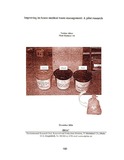| dc.description.abstract | BRAC has undertaken a pilot project on improving in-house medical waste management in
collaboration with three selected hospitals (Dhaka Shishu Hospital, Institute of Child Health
and Shishu Shasthya Foundation, and one BRAC upgraded Shushastha). As an outcome of
this project, a manual on in-house medical waste management has been prepared. The pilot
programme was designed to build awareness/consciousness among hospital staff and initiate
some action programs with the hospital staff to streamline the existing waste management
systems. To make the pilot programme successful the following steps were selected: i)
baseline survey, ii) manual development and training, iii) implementation and follow up, and
iv) finalize the manual on in-house medical waste management. The eight-month long project
was implemented during January-August 2004. Baseline survey found that, a number of
hospital staff specifically nurses and cleaners had been suffering from various kinds of
infectious diseases, such as hepatitis B/C, skin disease/allergy, infection, diarrhoea, fever,
headache, cough, asthma, and typhoid. Nurses were mostly injured during needle breaking
(42%) and ampoule breaking (34%), and cleaners were injured during handling and cleaning
waste. It was found that, 60% of sold items were plastics collected by unauthorized waste
pickers such as used syringes, saline bags, water bottles, etc. from hospitals. After
introducing the in-house management system in three hospitals, the amount of infectious
waste became around 2%, recyclable 4-6% and above 90% were general waste that could be
dumped to the municipal bin without treatment. Nevertheless, it should be kept in mind that
the amount and quality of waste depends on proper segregation, hospital size, services,
diseases type, waste category, and seasonality. To improve the medical waste management in
Bangladesh, we recommend the following: i) raising awareness, training, and capacity
building of hospital staff, ii) responsibilities inside hospital (designated personnel), iii)
monitoring mechanism and committee, iv) role of City Corporation (transportation and
central treatment system), v) hospital initiatives for proper medical waste management (cost,
return), and vi) private sector and NGOs involvement. | en_US |

